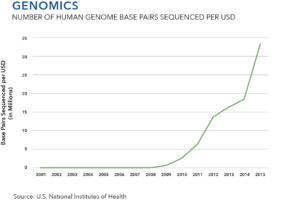Genomics, Bioengineering, and Health Technology
Advances in genomics, bioengineering, and health technologies have the potential to enable longevity, facilitate better health throughout the human lifespan, increase food supplies, and enhance performance. All of these developments drive a multitude of second- and third-order effects and represent a shift as significant as the 1928 discovery of penicillin, which not only increased infection survivability but also led to the rapid expansion of the pharmaceutical industry. Innovations that have the potential to broadly affect health and lifespan are things we need to pay attention to, as they affect what people do, where they live, what they buy, and how they vote.
Genomics and bioengineering are related fields that comprise the study and manipulation of a human, animal, or plant’s genetic material. This field has advanced significantly since the Human Genome Project, which was launched in 1990 and successfully mapped the sequence of nucleotide base pairs that make up human DNA. The Human Genome Project cost around $3 billion and took 13 years to complete. DNA sequencing can now be done in a day for less than $1,000. Illumina, an American biotechnology company, unveiled a new machine in January 2017 that it claims will reduce this cost to under $100 and will take less than an hour.
This is indicative of the speed at which this field is progressing. Researchers have moved past the point of focusing on understanding how genetics works to how to manipulate targeted genes towards specific outcomes. A number of different methods, techniques, and therapies have grown out of genomics research. CRISPR/Cas9 gene editing is one of the most interesting of these technologies, as it allows for the permanent modification of genes within living organisms. To vastly oversimplify, researchers are able to use the CRISPR/Cas9 system to effectively cut a strand of DNA at a specific location and replace it with a pre-designed RNA sequence that binds to and alters the original DNA strand. Plants and animals have been manipulated with CRISPR to change color, muscle tone, fur, yield, and a variety of other characteristics. This technology was first used in humans in October 2016 by Chinese scientists at Sichuan University in Chengdu as part of a clinical trial against lung cancer. American scientists used it to treat a mouse model of muscular dystrophy in January 2016, which marked the first successful treatment of a genetic disease inside a fully developed living mammal.
Again, CRISPR/Cas9 is one of many technologies in the field of genomics and bioengineering. These technologies and techniques will provide new tools to cure disease and increase longevity through medical treatments customized to the genome of each individual patient. Consider an antibiotic that can be tailored to the precise genome of the pathogen attacking a patient’s immune system, or a cancer therapy that can seek and destroy the DNA of cancer cells specific to a particular patient. Having said this, customized medicine will be a significant challenge for the regulatory bodies of the US and other nations with the mandate to approve drugs for use.
In the US system—regulated by the Food and Drug Administration (FDA)—a drug spends five to ten years in research and development, then another five to ten years in the trial process before being considered for FDA approval and sale. Bioengineering will shift this entire paradigm, disrupting both the pharmaceutical industry and the regulatory process overseen by government agencies. Going forward, targeted drugs could be designed for an individual’s specific genetic profile, which has the potential to significantly increase the effectiveness of certain categories of drugs. In an environment of custom drugs, the paradigm of testing drugs on a small group of people in clinical trials, watching what happens, and then approving them for broader use does not make sense. Timelines are another issue, as it currently takes an average of 12 years and $350 million to take a new drug from the laboratory to the pharmacy shelf. One could argue whether or not that makes sense now, but it certainly does not make sense in an environment of custom drug applications.
Genomics and bioengineering will also have deep implications in the production of food, modifying crops and livestock to increase yield and survivability in new climates. The shift from genetically enhanced foods—which we already see in GMOs—to genetically designed foods is the next manifestation of this trend. The ability to develop traditionally livestock-based food like meat within a lab rather than on farms will drastically increase the yield and accessibility of quality protein sources around the world. Beyond the obvious benefit of being able to feed more people at lower cost, the environmental benefits of bioengineered food like in-vitro meat could be significant. Today, the largest contributor to greenhouse gas emissions comes from raising livestock on land. In-vitro meat could reduce these emissions by as much as 90 percent and land use by as much as 99 percent.
As these capabilities increase the availability of effective medical therapies and nutritious, less costly food, they will almost certainly contribute to a longer average human lifespan, as well as better health later in life. This will lead to a number of significant decisions and implications for both business and public sector leaders. Our understanding of retirement age will change, how we structure the eligibility requirements for a variety of social services will shift, and how companies think about attracting, training, and enabling their workers to be productive later in life will need to be adjusted.
This will also impact the types of private sector products and public sector services that will be needed. There are a number of second- and third-order effects of increasing the average age of a population. Products, services, transportation solutions, and living preferences are all considerations, as are the capital requirements to support retiree programs, which cost more when people live longer. It is imperative that leaders in the public sector have discussions surrounding these changes and build out a new framework for social services now, rather than waiting until the world begins to see the mass impact of this catalyst.
Health Technology
Another rapidly advancing field of technology related to health and physical capabilities involves devices used on or embedded in the body to measure and enhance health and performance. Health technologies encompass a number of overlapping terms such as biotechnology, wearables, bioinformatics, biomanufacturing, and human-computer interfaces.
An early example of embedded health technology is the artificial cardiac pacemaker, which was first clinically implanted into a human in Sweden in 1958. Wearable technologies such as Fitbit and the Apple Watch are manifestations of the same broad product family—using technologies on and in our bodies to improve health outcomes. These capabilities are set to expand significantly as computing devices become smaller due to advances in chipsets, connectivity becomes more prevalent due to Internet-of-Things technologies, and software becomes more capable due to the increasing integration of machine-learning algorithms.
Several emerging health technologies lead us to believe that these developments could represent a catalyst that is broadly relevant, as opposed to merely incremental improvements of current wearables. One area of development is embedded sensors and devices that circulate through the bloodstream, monitoring and eventually helping to address health issues. Another is contact lenses that bring datasets directly into people’s lives and workflows, enabling new ecosystems for software applications and product experiences. A third are exoskeletons that increase performance and capability such as the Tactical Assault Light Operator Suit (TALOS), which is a robotic exoskeleton being developed by the United States Special Operations Command.
The intersection of health technology and neuroscience is also specifically interesting as relates to cognitive enhancement and mind-machine interfaces. External wearables that interact with the body are already in use; you currently have a computer on your desk, in your pocket, and potentially on your wrist. Next, there will likely be one in your bloodstream to keep you healthy, and in your eye or skull to augment your ability to interact with the world. The data extracted from this connection of body and machine will allow closer and closer integration between biological and technological systems to improve health, productivity, and capability.
Health technology enables better health outcomes later in life, similar to genomics and bioengineering. These technologies also have the potential to enhance the capability of people in both life and work environments. This does not have to be as science-fiction sounding as a robotic exoskeleton that fights terrorists in order to be important. For example, the smartphone is a near-wearable technology that has enhanced human capability. Think of the new product and software ecosystems, ways of customer interactions, and information systems that were built as a result of the smartphone. People now have computers and access to the internet in their pockets at all time. We view the next generation of health technologies in this light, as tools that will not only increase health outcomes but also create new platforms and product ecosystems that business and public sector leaders will need to understand and adapt to.
Ethical Considerations
While these technologies have the potential to provide tremendous benefits in terms of health, longevity, and disease prevention, they are accompanied by significant ethical considerations, some of which we as a species have never had to address. On the less complex end of this spectrum, we find concerns such as the privacy issues that come with the mainstream expansion of quantified self- and health-data technologies, and the unknown health implications of eating genetically modified foods for extended periods of time. These are serious issues, to be certain, but they pale in comparison to the ethics of human genetic engineering.
Gene-editing technologies such as CRISPR are currently being designed to heal genetic-based diseases, such as sickle-cell anemia. In the near future, doctors will be able to correct some of the faulty genes that lead to these ailments. This is called genome surgery, but it does not affect germ cells, meaning that the changes to the DNA would not be passed on to future generations. With CRISPR, germ-line engineering is possible, meaning that scientists can or will be able to make inheritable edits to the human genetic code.
Alongside other developments, this leads us to an environment where the human embryo can also be edited, and those edits would be passed on to future generations. These discoveries are generally viewed positively in context of their ability to prevent or preemptively cure genetic disorders such as Down Syndrome and Duchenne Muscular Dystrophy. However, the same process could be used to prevent predispositions towards hair loss and obesity, and ultimately to increase lung capacity, intelligence, speed, and other physical characteristics. We are still 10-20 years away from that point, but most scientists agree that it is coming. Importantly, the history of this field leads us to believe that most tend to overestimate the time it will take to reach new technological milestones.
According to an MIT survey, 46 percent of US adults believe that changing a baby’s genetic characteristics for the purpose of reducing the risk of serious diseases is appropriate. Only 15 percent of the same respondents believed that it is appropriate to change a baby’s genetic characteristics to make the baby more intelligent. These are significant and difficult questions to address as a society. It is not as simple as a decision by the FDA to allow or disallow this research or those procedures. This work is being done by scientists and researchers around the globe, and whether or not to implement these procedures will not solely be an American decision. How will the public decision-making calculus change if other nations are engineering smarter and stronger children? What if these technologies are extremely expensive and thus only available to the ultra-wealthy?
We do not presume to have the answers to these difficult issues, but as with other catalysts, we believe that leaders must be proactive. It is far better to understand and work to shape the emerging environment than it is to react after it happens. Addressing these issues in a thoughtful, comprehensive fashion will take courage. It will undoubtedly be risky for leaders who choose to do so, but the alternative—resigning leadership to technology—is akin to allowing the tail to wag the dog.
Join the Catalyst Monitor
Join our community, where we push out regular insights to help maintain situational awareness on technological and socioeconomic trends.




